甲基磺酸MSDS
- 格式:docx
- 大小:17.25 KB
- 文档页数:3
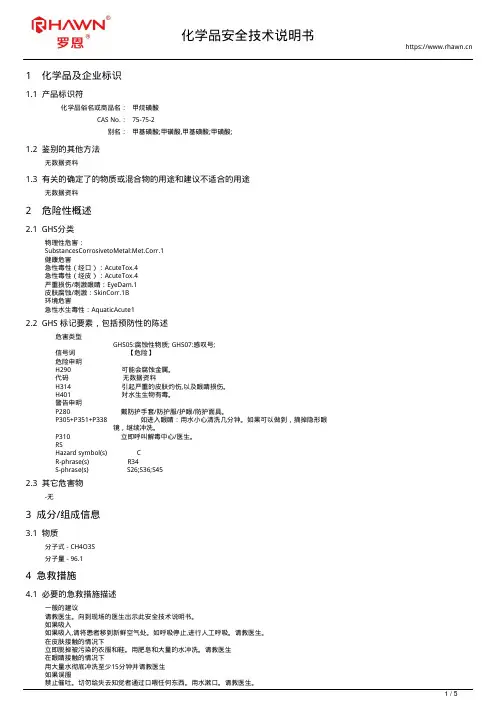

甲基磺酸(Methylsulfonic acid)是一种有机硫化合物,具有强烈的腐蚀性和脱水性,常用于化工生产、制药、染料制造、石油加工等领域。
由于其具有高度的腐蚀性和环境毒性,甲基磺酸的质量标准通常会涉及以下几个方面:
1. 纯度:甲基磺酸的纯度是其质量的重要指标之一。
工业级甲基磺酸的纯度一般要求在98%以上,而实验室级或特殊用途的甲基磺酸可能需要更高的纯度,如99%或更高。
2. 水分:甲基磺酸中的水分含量也会影响其质量。
水分含量的控制通常是为了确保甲基磺酸在储存和使用过程中的稳定性和腐蚀性。
工业级甲基磺酸通常要求水分含量不超过某个特定值,例如1%。
3. 杂质:甲基磺酸中的杂质含量也需要严格控制,因为杂质可能会影响其使用效果或安全性。
杂质的种类和含量会根据产品的用途和标准而有所不同。
4. 密度和粘度:甲基磺酸的密度和粘度也是其质量控制的重要指标,这些物理性质会影响其在运输和应用过程中的行为。
5. 安全性:甲基磺酸的安全性包括其蒸气压、闪点、自燃点等,这些特性会直接影响其在储存和运输过程中的安全措施。
6. 环保标准:由于甲基磺酸对环境和人体健康有害,其生产和使用受到环保法规的严格限制。
甲基磺酸的生产和处理过程中需要采取措施减少对环境的影响。
具体到甲基磺酸的质量标准,不同国家和地区的法规、行业标准可能有所不同。
在中国,例如,甲基磺酸的质量标准可能会遵循中国国家标准(GB标准)或行业标准,这些标准会详细规定甲基磺酸的质量指标、测试方法、包装、储存和运输要求等。
在购买和使用甲基磺酸时,应确保产品符合当地法律法规和行业标准,并在专业人员的指导下安全操作。
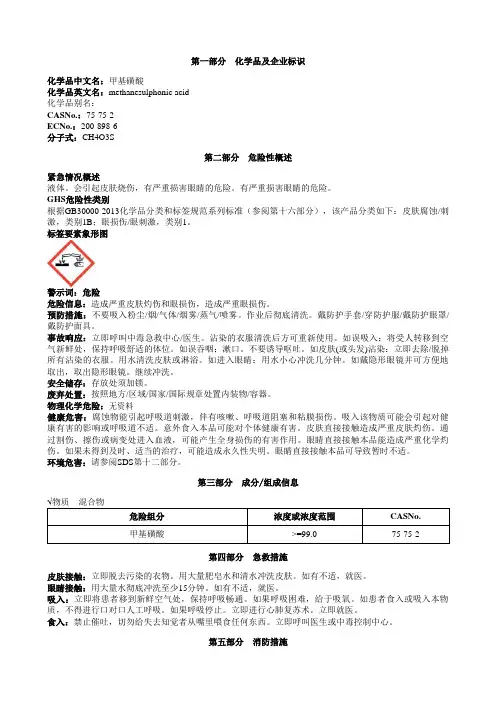
第一部分化学品及企业标识化学品中文名:甲基磺酸化学品英文名:methanesulphonic acid化学品别名:-CASNo.:75-75-2ECNo.:200-898-6分子式:CH4O3S第二部分危险性概述紧急情况概述液体。
会引起皮肤烧伤,有严重损害眼睛的危险。
有严重损害眼睛的危险。
GHS危险性类别根据GB30000-2013化学品分类和标签规范系列标准(参阅第十六部分),该产品分类如下:皮肤腐蚀/刺激,类别1B;眼损伤/眼刺激,类别1。
标签要素象形图警示词:危险危险信息:造成严重皮肤灼伤和眼损伤,造成严重眼损伤。
预防措施:不要吸入粉尘/烟/气体/烟雾/蒸气/喷雾。
作业后彻底清洗。
戴防护手套/穿防护服/戴防护眼罩/戴防护面具。
事故响应:立即呼叫中毒急救中心/医生。
沾染的衣服清洗后方可重新使用。
如误吸入:将受人转移到空气新鲜处,保持呼吸舒适的体位。
如误吞咽:漱口。
不要诱导呕吐。
如皮肤(或头发)沾染:立即去除/脱掉所有沾染的衣服。
用水清洗皮肤或淋浴。
如进入眼睛:用水小心冲洗几分钟。
如戴隐形眼镜并可方便地取出,取出隐形眼镜。
继续冲洗。
安全储存:存放处须加锁。
废弃处置:按照地方/区域/国家/国际规章处置内装物/容器。
物理化学危险:无资料健康危害:腐蚀物能引起呼吸道刺激,伴有咳嗽、呼吸道阻塞和粘膜损伤。
吸入该物质可能会引起对健康有害的影响或呼吸道不适。
意外食入本品可能对个体健康有害。
皮肤直接接触造成严重皮肤灼伤。
通过割伤、擦伤或病变处进入血液,可能产生全身损伤的有害作用。
眼睛直接接触本品能造成严重化学灼伤。
如果未得到及时、适当的治疗,可能造成永久性失明。
眼睛直接接触本品可导致暂时不适。
环境危害:请参阅SDS第十二部分。
第三部分成分/组成信息第四部分急救措施皮肤接触:立即脱去污染的衣物。
用大量肥皂水和清水冲洗皮肤。
如有不适,就医。
眼睛接触:用大量水彻底冲洗至少15分钟。
如有不适,就医。
吸入:立即将患者移到新鲜空气处,保持呼吸畅通。

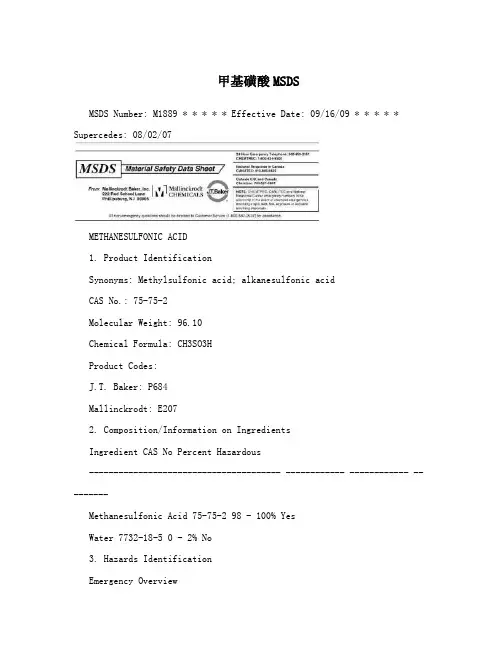
甲基磺酸MSDSMSDS Number: M1889 * * * * * Effective Date: 09/16/09 * * * * * Supercedes: 08/02/07METHANESULFONIC ACID1. Product IdentificationSynonyms: Methylsulfonic acid; alkanesulfonic acidCAS No.: 75-75-2Molecular Weight: 96.10Chemical Formula: CH3SO3HProduct Codes:J.T. Baker: P684Mallinckrodt: E2072. Composition/Information on IngredientsIngredient CAS No Percent Hazardous--------------------------------------- ------------ ------------ ---------Methanesulfonic Acid 75-75-2 98 - 100% YesWater 7732-18-5 0 - 2% No3. Hazards IdentificationEmergency Overview--------------------------DANGER! CORROSIVE. CAUSES SEVERE BURNS TO EVERY AREA OF CONTACT. HARMFUL IF SWALLOWED OR INHALED. VAPOR IS SEVERELY IRRITATING TO EYESAND RESPIRATORY TRACT.(tm)SAF-T-DATA Ratings (Provided here for your convenience)-----------------------------------------------------------------------------------------------------------Health Rating: 3 - Severe (Poison)Flammability Rating: 1 - SlightReactivity Rating: 1 - SlightContact Rating: 4 - Extreme (Corrosive)Lab Protective Equip: GOGGLES & SHIELD; LAB COAT & APRON; VENT HOOD; PROPER GLOVES Storage Color Code: White (Corrosive)-----------------------------------------------------------------------------------------------------------Potential Health Effects----------------------------------Inhalation:Inhalation produces damaging effects on the mucous membranes andupper respiratory tract. Symptoms may include irritation of the nose and throat, and labored breathing. May cause lung edema, a medical emergency.Ingestion:Corrosive. Swallowing can cause severe burns of the mouth, throat,and stomach. Can cause sore throat, vomiting, diarrhea.Skin Contact:Corrosive. Symptoms of redness, pain, and severe burn can occur.Eye Contact:Corrosive! Vapors are severely irritating and may cause damage tothe eyes. Contact may cause severe burns and permanent eye damage.Chronic Exposure:No information found.Aggravation of Pre-existing Conditions:Persons with pre-existing skin conditions or impaired respiratory function may be more susceptible to the effects of this substance.4. First Aid MeasuresInhalation:Remove to fresh air. If not breathing, give artificial respiration.If breathing is difficult, give oxygen. Get medical attention immediately.Ingestion:If swallowed, DO NOT INDUCE VOMITING. Give large quantities of water. Never give anything by mouth to an unconscious person. Get medical attention immediately.Skin Contact:Immediately flush skin with plenty of water for at least 15 minutes while removing contaminated clothing and shoes. Get medical attention immediately. Wash clothing before reuse. Thoroughly clean shoes before reuse.Eye Contact:Immediately flush eyes with plenty of water for at least 15 minutes, lifting lower and upper eyelids occasionally. Get medical attention immediately.5. Fire Fighting MeasuresFire:Not considered to be a fire hazard.Explosion:Not considered to be an explosion hazard.Fire Extinguishing Media:Water spray, dry chemical, alcohol foam, or carbon dioxide.pecial Information: SIn the event of a fire, wear full protective clothing and NIOSH-approved self-contained breathing apparatus with full facepiece operated in the pressure demand or other positive pressure mode.6. Accidental Release MeasuresVentilate area of leak or spill. Wear appropriate personalprotective equipment as specified in Section 8. Isolate hazard area. Keep unnecessary and unprotected personnel from entering. Contain and recover liquid when possible. Neutralize with alkaline material (soda ash, lime), then absorb with an inert material (e. g., vermiculite, dry sand, earth), and place in a chemical waste container. Do not use combustible materials, such as saw dust. Do not flush to sewer!7. Handling and StorageKeep in a tightly closed container, stored in a cool, dry,ventilated area. Protect against physical damage. Isolate from incompatible substances. Do not add water to acid while in the container because heat release may cause spattering. Containers of this material may be hazardous when empty since they retain product residues (vapors, liquid); observe all warnings and precautions listed for the product.8. Exposure Controls/Personal ProtectionAirborne Exposure Limits:None established.Ventilation System:A system of local and/or general exhaust is recommended to keep employee exposures as low as possible. Local exhaust ventilation is generally preferred because it can control the emissions of the contaminant at its source, preventing dispersion of it into the general work area. Please refer to the ACGIH document, Industrial Ventilation, A Manual of, most recent edition, for details. Recommended PracticesPersonal Respirators (NIOSH Approved):For conditions of use where exposure to the substance is apparent and engineering controls are not feasble, consult an industrial hygienist. For emergencies, or instances where the exposure levels are not known, use a full-facepiece positive-pressure, air-supplied respirator. WARNING: Air purifying respirators do not protect workers in oxygen-deficient atmospheres.Skin Protection:Wear impervious protective clothing, including boots, gloves, lab coat, apron or coveralls, as appropriate, to prevent skin contact.Eye Protection:Use chemical safety goggles and/or a full face shield where splashing is possible. Maintain eye wash fountain and quick-drench facilities in work area.9. Physical and Chemical PropertiesAppearance:Liquid at room temperature.Odor:Faint sulfur trioxide odor to odorless.Solubility:Soluble in water.Specific Gravity:1.5pH:No information found.% Volatiles by volume @ 21C (70F):Boiling Point:167C (333F) @ 10 mm HgMelting Point:20C (68F)Vapor Density (Air=1):No information found.Vapor Pressure (mm Hg):No information found.Evaporation Rate (BuAc=1):No information found.10. Stability and ReactivityStability:Stable under ordinary conditions of use and storage.Hazardous Decomposition Products:Burning may produce carbon monoxide, carbon dioxide, sulfur oxides. Hazardous Polymerization:Will not occur.Incompatibilities:Bases, amines, strong reducing agents, ethyl vinyl ether, hydrofluoric acid and strong oxidizers.Conditions to Avoid:Heat, incompatibles.11. Toxicological InformationOral rat LD50: 200 mg/kg. Investigated as a mutagen.--------\Cancer Lists\---------------------------------------------------------NTP Carcinogen---Ingredient Known Anticipated IARC Category------------------------------------ ----- ----------- ------------- Methanesulfonic Acid (75-75-2) No No NoneWater (7732-18-5) No No None12. Ecological InformationEnvironmental Fate:When released into the soil, this material may leach into groundwater. When released into the soil, this material may evaporate to a moderate extent. When released into water, this material is not expected to evaporate significantly. This material is not expected to significantly bioaccumulate. When released into the air, this material may be moderately degraded by reaction with photochemically produced hydroxyl radicals. When released into the air, this material may be removed from the atmosphere to a moderate extent by wet deposition. When released into the air, this material may be removed from the atmosphere to a moderate extent by dry deposition. When released into the air, this material is expected to have a half-life of greater than 30 days.Environmental Toxicity:No information found.13. Disposal ConsiderationsWhatever cannot be saved for recovery or recycling should be managed in an appropriate and approved waste facility. Although not a listed RCRA hazardous waste, this material may exhibit one or more characteristics of a hazardous waste and require appropriate analysis to determine specific disposal requirements. Processing, use orcontamination of this product may change the waste management options. State and local disposal regulations may differ from federal disposal regulations. Dispose of container and unused contents in accordance with federal, state and local requirements.14. Transport InformationDomestic (Land, D.O.T.)-----------------------Proper Shipping Name: CORROSIVE LIQUID, TOXIC, N.O.S. (METHANESULFONIC ACID) Hazard Class: 8, 6.1UN/NA: UN2922Packing Group: IIInformation reported for product/size: 5KGInternational (Water, I.M.O.)-----------------------------Proper Shipping Name: CORROSIVE LIQUID, TOXIC, N.O.S. (METHANESULFONIC ACID) Hazard Class: 8, 6.1UN/NA: UN2922Packing Group: IIInformation reported for product/size: 5KGInternational (Air, I.C.A.O.)-----------------------------Proper Shipping Name: CORROSIVE LIQUID, TOXIC, N.O.S. (METHANESULFONIC ACID) Hazard Class: 8, 6.1UN/NA: UN2922Packing Group: IIInformation reported for product/size: 5KG15. Regulatory Information--------\Chemical Inventory Status - Part 1\---------------------------------Ingredient TSCA EC Japan Australia----------------------------------------------- ---- --- ----- ---------Methanesulfonic Acid (75-75-2) Yes Yes Yes YesWater (7732-18-5) Yes Yes Yes Yes--------\Chemical Inventory Status - Part 2\-----------------------------------Canada--Ingredient Korea DSL NDSL Phil.----------------------------------------------- ----- --- ---- ----- Methanesulfonic Acid (75-75-2) Yes Yes No Yes Water (7732-18-5) Yes Yes No Yes--------\Federal, State & International Regulations - Part 1\-----------------SARA 302- ------SARA 313------Ingredient RQ TPQ List Chemical Catg.----------------------------------------- --- ----- ---- --------------Methanesulfonic Acid (75-75-2) No No No NoWater (7732-18-5) No No No No--------\Federal, State & International Regulations - Part 2\-----------------RCRA- -TSCA-Ingredient CERCLA 261.33 8(d)----------------------------------------- ------ ------ ------Methanesulfonic Acid (75-75-2) No No NoWater (7732-18-5) No No NoChemical Weapons Convention: No TSCA 12(b): No CDTA: No SARA 311/312: Acute: Yes Chronic: No Fire: No Pressure: No Reactivity: No (Pure / Liquid)Australian Hazchem Code: None allocated.Poison Schedule: None allocated.WHMIS:This MSDS has been prepared according to the hazard criteria of the Controlled Products Regulations (CPR) and the MSDS contains all of the information required by the CPR.16. Other InformationNFPA Ratings: Health: 3 Flammability: 1 Reactivity: 0Label Hazard Warning:DANGER! CORROSIVE. CAUSES SEVERE BURNS TO EVERY AREA OF CONTACT. HARMFUL IF SWALLOWED OR INHALED. VAPOR IS SEVERELY IRRITATING TO EYES AND RESPIRATORY TRACT.Label Precautions:Do not breathe vapor.Do not get in eyes, on skin, or on clothing.Keep container closed.Wash thoroughly after handling.Use only with adequate ventilation.Label First Aid:In case of contact, immediately flush skin with plenty of water for at least 15 minutes while removing contaminated clothing and shoes. Wash clothing before re-use. If inhaled, remove to fresh air. If not breathing, give artificial respiration. If breathing is difficult, give oxygen. If swallowed, DO NOT INDUCE VOMITING. Give large quantities of water. Never give anything by mouth to an unconscious person. In all cases get medical attention immediately. Product Use:Laboratory Reagent.Revision Information:No Changes.Disclaimer:******************************************************************** ****************************Mallinckrodt Baker, Inc. provides the information contained hereinin good faith but makes no representation as to its comprehensiveness or accuracy. This document is intended only as a guide to the appropriate precautionary handling of the material by a properly trained person using this product. Individuals receiving the information must exercisetheir independent judgment in determining its appropriateness for a particular purpose. MALLINCKRODT BAKER, INC. MAKES NO REPRESENTATIONS OR WARRANTIES, EITHER EXPRESS OR IMPLIED, INCLUDING WITHOUT LIMITATION ANY WARRANTIES OF MERCHANTABILITY, FITNESS FOR A PARTICULAR PURPOSE WITH RESPECT TO THE INFORMATION SET FORTH HEREIN OR THE PRODUCT TO WHICH THE INFORMATION REFERS. ACCORDINGLY, MALLINCKRODT BAKER, INC. WILL NOT BE RESPONSIBLE FORDAMAGES RESULTING FROM USE OF OR RELIANCE UPON THIS INFORMATION.************************************************************************ ************************Prepared by: Environmental Health & SafetyPhone Number: (314) 654-1600 (U.S.A.)。
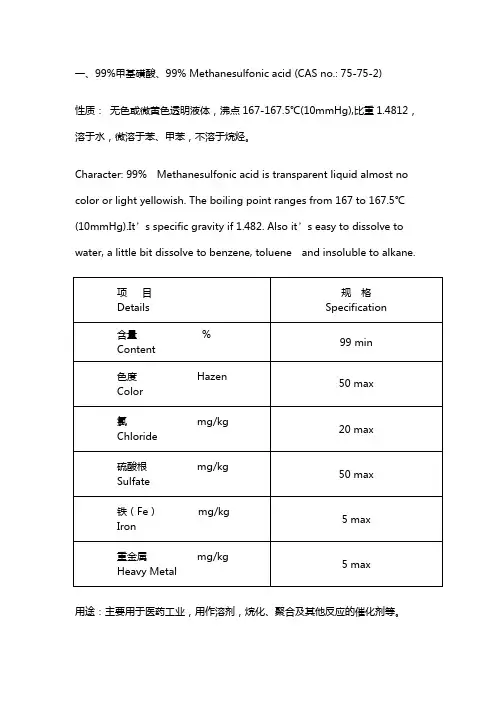
一、99%甲基磺酸、99% Methanesulfonic acid (CAS no.: 75-75-2)性质:无色或微黄色透明液体,沸点167-167.5℃(10mmHg),比重1.4812,溶于水,微溶于苯、甲苯,不溶于烷烃。
Character: 99% Methanesulfonic acid is transparent liquid almost no color or light yellowish. The boiling point ranges from 167 to 167.5℃(10mmHg).It’s specific gravity if 1.482. Also it’s easy to dissolve to water, a little bit dissolve to benzene, toluene and insoluble to alkane.用途:主要用于医药工业,用作溶剂,烷化、聚合及其他反应的催化剂等。
Usage: mainly being solvent in medical industry or catalyst for alkylation, polymerization or other chemical reaction.包装: 250kg塑料桶/30kg塑料桶/35kg塑料桶Package: In UN-approved plastic barrel of 250 kgs net weight for export.二、70%甲基磺酸Methanesulfonic acid (CAS no.: 75-75-2)性质:无色透明液体,沸点167-167.5℃(10mmHg), 溶于水,微溶于苯、甲苯,不溶于烷烃。
Character: 99% Methanesulfonic acid is transparent liquid almost no color or light yellowish. The boiling point ranges from 167 to 167.5℃(10mmHg).It’s specific gravity if 1.482. Also it’s easy to dissolve to water, a little bit dissolve to benzene, toluene and insoluble to alkane.用途: 70%甲基磺酸用于电子电镀行业。
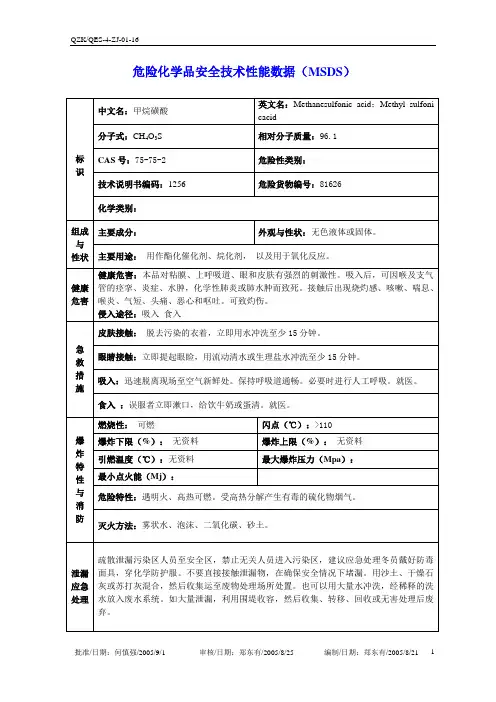
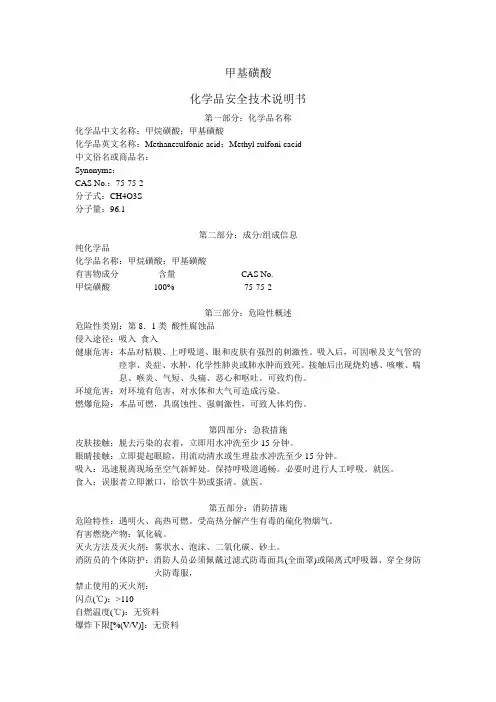
甲基磺酸化学品安全技术说明书第一部分:化学品名称化学品中文名称:甲烷磺酸;甲基磺酸化学品英文名称:Methanesulfonic acid;Methyl sulfoni cacid中文俗名或商品名:Synonyms:CAS No.:75-75-2分子式:CH4O3S分子量:96.1第二部分:成分/组成信息纯化学品化学品名称:甲烷磺酸;甲基磺酸有害物成分含量CAS No.甲烷磺酸100% 75-75-2第三部分:危险性概述危险性类别:第8.1类酸性腐蚀品侵入途径:吸入食入健康危害:本品对粘膜、上呼吸道、眼和皮肤有强烈的刺激性。
吸入后,可因喉及支气管的痉挛、炎症、水肿,化学性肺炎或肺水肿而致死。
接触后出现烧灼感、咳嗽、喘息、喉炎、气短、头痛、恶心和呕吐。
可致灼伤。
环境危害:对环境有危害,对水体和大气可造成污染。
燃爆危险:本品可燃,具腐蚀性、强刺激性,可致人体灼伤。
第四部分:急救措施皮肤接触:脱去污染的衣着,立即用水冲洗至少15分钟。
眼睛接触:立即提起眼睑,用流动清水或生理盐水冲洗至少15分钟。
吸入:迅速脱离现场至空气新鲜处。
保持呼吸道通畅。
必要时进行人工呼吸。
就医。
食入:误服者立即漱口,给饮牛奶或蛋清。
就医。
第五部分:消防措施危险特性:遇明火、高热可燃。
受高热分解产生有毒的硫化物烟气。
有害燃烧产物:氧化硫。
灭火方法及灭火剂:雾状水、泡沫、二氧化碳、砂土。
消防员的个体防护:消防人员必须佩戴过滤式防毒面具(全面罩)或隔离式呼吸器、穿全身防火防毒服,禁止使用的灭火剂:闪点(℃):>110自燃温度(℃):无资料爆炸下限[%(V/V)]:无资料爆炸上限[%(V/V)]:无资料最小点火能(mJ):爆燃点:爆速:最大燃爆压力(MPa):建规火险分级:第六部分:泄漏应急处理应急处理:疏散泄漏污染区人员至安全区,禁止无关人员进入污染区,建议应急处理冬员戴好防毒面具,穿化学防护服。
不要直接接触泄漏物,在确保安全情况下堵漏。
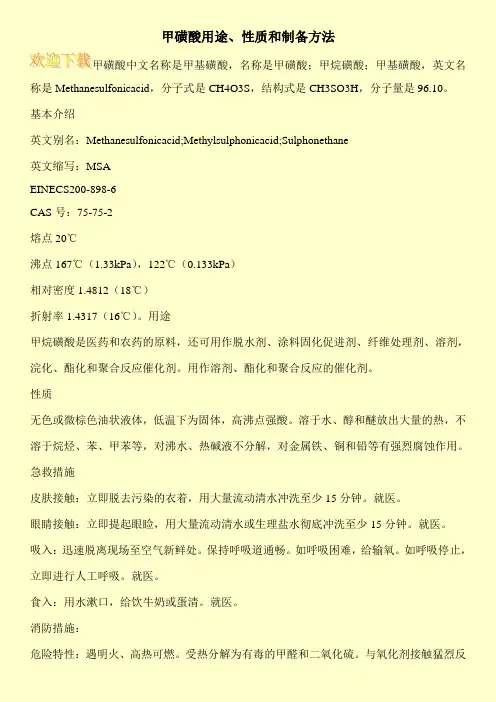
甲磺酸用途、性质和制备方法
甲磺酸中文名称是甲基磺酸,名称是甲磺酸;甲烷磺酸;甲基磺酸,英文名称是Methanesulfonicacid,分子式是CH4O3S,结构式是CH3SO3H,分子量是96.10。
基本介绍
英文别名:Methanesulfonicacid;Methylsulphonicacid;Sulphonethane
英文缩写:MSA
EINECS200-898-6
CAS号:75-75-2
熔点20℃
沸点167℃(1.33kPa),122℃(0.133kPa)
相对密度1.4812(18℃)
折射率1.4317(16℃)。
用途
甲烷磺酸是医药和农药的原料,还可用作脱水剂、涂料固化促进剂、纤维处理剂、溶剂,浣化、酯化和聚合反应催化剂。
用作溶剂、酯化和聚合反应的催化剂。
性质
无色或微棕色油状液体,低温下为固体,高沸点强酸。
溶于水、醇和醚放出大量的热,不溶于烷烃、苯、甲苯等,对沸水、热碱液不分解,对金属铁、铜和铅等有强烈腐蚀作用。
急救措施
皮肤接触:立即脱去污染的衣着,用大量流动清水冲洗至少15分钟。
就医。
眼睛接触:立即提起眼睑,用大量流动清水或生理盐水彻底冲洗至少15分钟。
就医。
吸入:迅速脱离现场至空气新鲜处。
保持呼吸道通畅。
如呼吸困难,给输氧。
如呼吸停止,立即进行人工呼吸。
就医。
食入:用水漱口,给饮牛奶或蛋清。
就医。
消防措施:
危险特性:遇明火、高热可燃。
受热分解为有毒的甲醛和二氧化硫。
与氧化剂接触猛烈反。
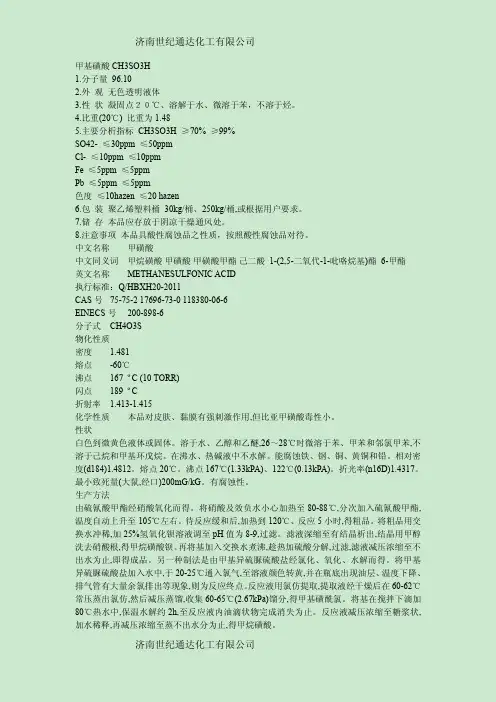
甲基磺酸CH3SO3H1.分子量96.102.外观无色透明液体3.性状凝固点20℃、溶解于水、微溶于苯,不溶于烃。
4.比重(20℃)比重为1.485.主要分析指标CH3SO3H≥70%≥99%SO42-≤30ppm≤50ppmCl-≤10ppm≤10ppmFe≤5ppm≤5ppmPb≤5ppm≤5ppm色度≤10hazen≤20hazen6.包装聚乙烯塑料桶30kg/桶、250kg/桶,或根据用户要求。
7.储存本品应存放于阴凉干燥通风处。
8.注意事项本品具酸性腐蚀品之性质,按照酸性腐蚀品对待。
中文名称甲磺酸中文同义词甲烷磺酸甲磺酸甲磺酸甲酯己二酸1-(2,5-二氧代-1-吡咯烷基)酯6-甲酯英文名称METHANESULFONIC ACID执行标准:Q/HBXH20-2011CAS号75-75-217696-73-0118380-06-6EINECS号200-898-6分子式CH4O3S物化性质密度 1.481熔点-60℃沸点167ºC(10TORR)闪点189ºC折射率 1.413-1.415化学性质本品对皮肤、黏膜有强刺激作用,但比亚甲磺酸毒性小。
性状白色到微黄色液体或固体。
溶于水、乙醇和乙醚,26~28℃时微溶于苯、甲苯和邻氯甲苯,不溶于己烷和甲基环戊烷。
在沸水、热碱液中不水解。
能腐蚀铁、钢、铜、黄铜和铅。
相对密度(d184)1.4812。
熔点20℃。
沸点167℃(1.33kPA)、122℃(0.13kPA)。
折光率(n16D)1.4317。
最小致死量(大鼠,经口)200mG/kG。
有腐蚀性。
生产方法由硫氰酸甲酯经硝酸氧化而得。
将硝酸及效负水小心加热至80-88℃,分次加入硫氰酸甲酯,温度自动上升至105℃左右。
待反应缓和后,加热到120℃、反应5小时,得粗品。
将粗品用交换水冲稀,加25%氢氧化钡溶液调至pH值为8-9,过滤。
滤液深缩至有结晶析出,结晶用甲醇洗去硝酸根,得甲烷磺酸钡。
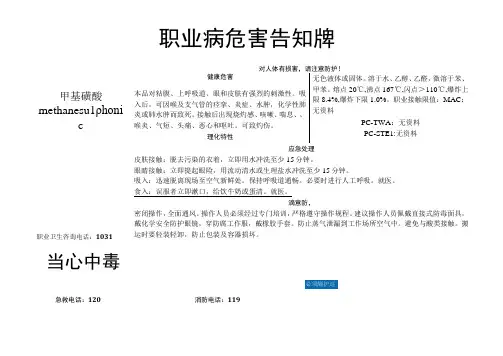
职业病危害告知牌 对人体有损害,请注意防护! 健康危害 本品对粘膜、上呼吸道、眼和皮肤有强烈的刺激性。
吸入后,可因喉及支气管的痉挛、炎症、水肿,化学性肺炎或肺水肿而致死。
接触后出现烧灼感、咳嗽、喘息、、喉炎、气短、头痛、恶心和呕吐。
可致灼伤。
理化特性 无色液体或固体。
溶于水、乙醇、乙醛,微溶于苯、甲苯。
熔点20℃,沸点167℃,闪点>110℃,爆炸上限8.4%,爆炸下限1.0%。
职业接触限值:MAC :无资料 PC-TWA :无资料 PC-STE1:无资料应急处理 皮肤接触:脱去污染的衣着,立即用水冲洗至少15分钟。
眼睛接触:立即提起眼险,用流动清水或生理盐水冲洗至少15分钟。
吸入:迅速脱离现场至空气新鲜处。
保持呼吸道通畅。
必要时进行人工呼吸。
就医。
食入:误服者立即漱口,给饮牛奶或蛋清。
就医。
滴意防, 密闭操作,全面通风。
操作人员必须经过专门培训,严格遵守操作规程。
建议操作人员佩戴直接式防毒面具,戴化学安全防护眼镜,穿防腐工作服,戴橡胶手套。
防止蒸气泄漏到工作场所空气中。
避免与酸类接触。
搬运时要轻装轻卸,防止包装及容器损坏。
职业卫生咨询电话:1031 当心中毒
急救电话:120 消防电话:119 甲基磺酸 methanesu1ρhoni
c
acid。
甲基磺酸用途一、甲基磺酸的基本介绍甲基磺酸是一种有机化合物,化学式为CH3SO3H,常温下为无色至微黄色液体。
它是一种强酸,具有类似硫酸的酸性和反应性。
甲基磺酸是一种重要的化学原料,在众多行业中具有广泛的用途。
二、甲基磺酸在染料行业中的应用2.1 染料合成中的催化剂甲基磺酸在染料合成中起着重要的催化剂作用。
染料合成通常需要使用强酸条件,而甲基磺酸正好具备这种特性,可以提供足够的酸性条件,促进染料合成反应的进行。
同时,甲基磺酸还能提高染料的色泽和亮度,改善染料的质量。
2.2 染料的酸性调节剂染料在染色过程中,需要通过调节酸碱度来控制染料的色彩和染色效果。
甲基磺酸作为一种强酸性物质,可以被用作染料的酸性调节剂。
通过调节甲基磺酸的用量,可以改变染料的色调,实现不同颜色的染色效果。
2.3 染料中的稳定剂在染料的储存和使用过程中,往往需要添加稳定剂来防止染料的变质和降解。
甲基磺酸具有良好的稳定性,并且能够与染料分子发生特殊的相互作用,使染料在储存和使用中更加稳定。
因此,甲基磺酸常被用作染料中的稳定剂,以延长染料的使用寿命。
三、甲基磺酸在药品制造中的应用3.1 酯类药物的合成剂甲基磺酸在药品制造中具有广泛的应用。
其中,酯类药物的合成是甲基磺酸最常见的应用之一。
在酯化反应中,甲基磺酸可以作为酸催化剂,促进酯化反应的进行,从而合成出多种酯类药物。
3.2 药物的酸碱调节剂类似于染料行业中的应用,甲基磺酸在药品制造中也可以作为酸碱调节剂使用。
不同药物在不同的酸碱环境下,其有效成分的释放和吸收情况会有所不同。
通过加入适量的甲基磺酸,可以调节药物的酸碱度,从而实现对药物效果的调节和优化。
3.3 药物的稳定剂与染料行业类似,甲基磺酸也可作为药品的稳定剂使用,以保证药品的质量和稳定性。
甲基磺酸可以与药物分子进行化学反应,形成稳定的化合物,从而延长药品的保存期限和有效期限。
四、甲基磺酸在其他领域中的应用4.1 电子材料行业甲基磺酸在电子材料行业中也有一定的应用。
危险化学品安全技术性能数据(MSDS)标识中文名:甲烷磺酸英文名:Methanesulfonicacid;Methyl sulfoni cacid 分子式:CH4O3S相对分子质量:96.1 CAS号:75-75-2危险性类别:技术说明书编码:1256危险货物编号:81626化学类别:组成与性状主要成分:外观与性状:无色液体或固体。
主要用途:用作酯化催化剂、烷化剂, 以及用于氧化反应。
健康危害健康危害:本品对粘膜、上呼吸道、眼和皮肤有强烈的刺激性。
吸入后,可因喉及支气管的痉挛、炎症、水肿,化学性肺炎或肺水肿而致死。
接触后出现烧灼感、咳嗽、喘息、喉炎、气短、头痛、恶心和呕吐。
可致灼伤。
侵入途径:吸入 食入急救措施皮肤接触:脱去污染的衣着,立即用水冲洗至少15分钟。
眼睛接触:立即提起眼睑,用流动清水或生理盐水冲洗至少15分钟。
吸入:迅速脱离现场至空气新鲜处。
保持呼吸道通畅。
必要时进行人工呼吸。
就医。
食入:误服者立即漱口,给饮牛奶或蛋清。
就医。
爆炸特性与消燃烧性:可燃闪点(℃):>110爆炸下限(%):无资料爆炸上限(%):无资料引燃温度(℃):无资料最大爆炸压力(Mpa):最小点火能(Mj):危险特性:遇明火、高热可燃。
受高热分解产生有毒的硫化防物烟气。
灭火方法:雾状水、泡沫、二氧化碳、砂土。
泄漏应急处理疏散泄漏污染区人员至安全区,禁止无关人员进入污染区,建议应急处理冬员戴好防毒面具,穿化学防护服。
不要直接接触泄漏物,在确保安全情况下堵漏。
用沙土、干燥石灰或苏打灰混合,然后收集运至废物处理场所处置。
也可以用大量水冲洗,经稀释的洗水放入废水系统。
如大量泄漏,利用围堤收容,然后收集、转移、回收或无害处理后废弃。
操作注意事项储运注意事项储存于阴凉、通风仓间内。
远离火种、热源。
保持容器密封。
应与氧化剂、碱类分开存放。
分装和搬运作业要注意个人防护。
搬运时要轻装轻卸,防止包装及容器损坏。
防护措施车间卫生标准:中国MAC(mg/m3):未制定标准前苏联MAC(mg/m3):未制定标准TLVTN:未制定标准TLVWN:未制定标准检测方法:工程控制:密闭操作,局部排风。
Page 1/7Material Safety Data SheetA ccording to 91/155 EECPrinting date 12.11.2004Reviewed on 05.11.2004(Contd. on page 2)A ccording to 91/155 EECPrinting date 12.11.2004Reviewed on 05.11.2004 Trade name:ZINN(II)-METHANSULFONAT, Lsg.ca. 300g/l Sn(Contd. of page 1)A ccording to 91/155 EECPrinting date 12.11.2004Reviewed on 05.11.2004 Trade name:ZINN(II)-METHANSULFONAT, Lsg.ca. 300g/l Sn(Contd. of page 2)· Storage class8A ccording to 91/155 EECPrinting date 12.11.2004Reviewed on 05.11.2004 Trade name:ZINN(II)-METHANSULFONAT, Lsg.ca. 300g/l Sn(Contd. of page 3) Odour:Weak, characteristic· Change in conditionMelting point/Melting range:Not determinedBoiling point/Boiling range:ca. 130°C· Flash point:Not applicable· Self-inflammability:Product is not selfigniting.· Danger of explosion:Product is not explosive.· Specific gravity at 20°C:< 1.5 g/cm³· Solubility in / Miscibility withWater:Fully miscible· pH-value at 20°C: 1A ccording to 91/155 EECPrinting date 12.11.2004Reviewed on 05.11.2004 Trade name:ZINN(II)-METHANSULFONAT, Lsg.ca. 300g/l Sn(Contd. of page 4) Must not reach sewage water or drainage ditch undiluted or unneutralized.A ccording to 91/155 EECPrinting date 12.11.2004Reviewed on 05.11.2004 Trade name:ZINN(II)-METHANSULFONAT, Lsg.ca. 300g/l Sn(Contd. of page 5)· Air transport ICAO-TI and IATA-DGR:· ICAO/IATA Class:8· UN/ID Number:3265· Label8· Packaging group:III· Proper shipping name:CO RR OSIVE LIQ UID, ACIDIC, O RG ANIC,N.O.S. (TIN(II)methanesulphonate, methanesulphonic acid)A ccording to 91/155 EECPrinting date 12.11.2004Reviewed on 05.11.2004 Trade name:ZINN(II)-METHANSULFONAT, Lsg.ca. 300g/l Sn(Contd. of page 6)· Relevant R-phrases22Harmful if swallowed.34Causes burns.43May cause sensitization by skin contact.GB。